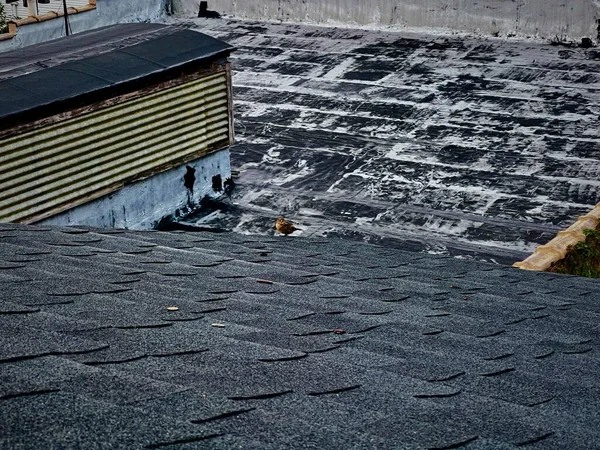Signs of Storm Damage on Your Roof and What to Do Next
Your roof is one of the most critical components of your home’s structure, offering protection from rain, wind, hail, snow, and other harsh weather elements. However, even the most well-built roofs aren’t immune to nature’s wrath. After a severe storm, identifying the signs of storm damage on your roof is essential for maintaining the safety and integrity of your property. Failing to address storm damage promptly can lead to water intrusion, mold, higher utility bills, and more expensive repairs in the future.
In this comprehensive guide, we’ll walk you through how to spot storm damage, what steps to take after the storm clears, and how to safeguard your roof moving forward.

Common Types of Storms That Affect Roofs
Storms vary in intensity and type, and each one can affect your roof in different ways:
- Windstorms: Strong winds can tear off shingles, lift flashing, or even rip sections of the roof entirely if the structure is compromised.
- Hailstorms: Hailstones vary in size and density but can cause significant surface-level damage, particularly to asphalt shingles, leaving behind dents, cracks, or punctures.
- Thunderstorms: Often combining wind, rain, and lightning, these storms can cause tree limbs to crash into your roof, break tiles, or cause internal leaks.
- Snowstorms: The weight of accumulated snow and the formation of ice dams can stress roofing materials, leading to sagging, water backup, and potential collapses.
- Hurricanes and tropical storms: These powerful weather systems often bring sustained winds, driving rain, and flying debris, making them among the most destructive for residential roofs.

Telltale Signs of Storm Damage on Your Roof
Knowing what to look for after a storm is crucial. These are the most common and important signs of storm damage on your roof:
1. Missing or Damaged Shingles
If you notice bare patches on your roof or shingles lying in your yard after a storm, it’s a major red flag. High winds can easily lift and remove shingles, particularly if they were already loose or aging. Even if shingles are only partially lifted, they can allow water to seep underneath and damage the underlying roofing materials. Over time, this can lead to rotting wood, mold, and structural decay. Damaged shingles may also appear curled, cracked, or split down the middle.
2. Granule Loss
Asphalt shingles are coated with granules that protect them from UV rays and improve their water resistance. After a severe storm—especially one involving hail or heavy rain—you might find that these granules have been knocked loose. They often collect in gutters or at the base of your downspouts. Excessive granule loss significantly reduces the lifespan of your roof and is one of the more subtle signs of storm damage on your roof that can go unnoticed until serious issues emerge.
3. Dents and Impact Marks
Hail can leave noticeable dents on your roof’s surface. While they may look small, these dents can weaken the structural integrity of shingles or metal components like flashing and vents. In some cases, the shingle mat beneath the surface granules may be exposed or fractured, reducing its ability to shed water. You may also find indentations on skylights, gutters, or even chimney caps—any of which indicate that your roof took a beating.
4. Leaks or Water Stains
Water intrusion is one of the most urgent and dangerous consequences of roof damage. If you notice water stains on your ceilings or walls, peeling paint, or musty odors in your attic or upper floors, this could be a sign that water has already found its way in. Leaks might not appear immediately after a storm, but they often begin where shingles were compromised or flashing was dislodged.
5. Debris and Clogged Gutters
After a storm, it’s common for leaves, twigs, and even large branches to land on your roof. While some debris might seem harmless, large items can break shingles or punch holes in the roofing. Additionally, clogged gutters prevent proper water drainage, which can lead to pooling and increased moisture damage at the roofline. It’s a lesser-known but important sign of storm damage on your roof.
6. Sagging or Uneven Roof Lines
If you notice your roof looks wavy or uneven after a storm, this could suggest deeper structural problems. Sagging often occurs when moisture infiltrates the wooden decking below the shingles, causing it to warp or rot. This can also result from the weight of snow or ice that stresses the structure over time. A sagging roof should be evaluated by a roofing contractor as soon as possible to avoid collapse.
7. Loose or Exposed Flashing
Flashing is used around chimneys, skylights, and roof valleys to seal joints and prevent water entry. Storms with strong winds can peel flashing away from the roof or loosen the sealant. When this happens, rainwater can seep into places that are otherwise well-protected, eventually damaging insulation, walls, and ceilings inside your home.
8. Interior Drafts or Temperature Changes
If your attic or upper rooms feel draftier than usual or your energy bills spike after a storm, this could indicate gaps or breaches in the roofing system. Wind-driven damage may have removed insulation, cracked ventilation covers, or displaced roofing materials—leading to inefficiencies and letting cold or warm air enter.
What to Do After Spotting Storm Damage
Once you’ve identified any signs of storm damage on your roof, it’s crucial to act quickly. Here’s what you should do next:
1. Ensure Your Safety
Don’t rush to climb onto your roof immediately after a storm. Wet or damaged surfaces can be extremely slippery and dangerous. Your safety should always come first.
2. Conduct a Visual Inspection from the Ground
Walk around your home’s perimeter and use binoculars if necessary. Look for visible damage like missing shingles, dented gutters, or torn flashing. This quick overview can help determine if a more detailed professional inspection is needed.
3. Document All Damage Thoroughly
Take clear photographs of any damage to your roof, siding, windows, or yard. These images will serve as evidence when filing an insurance claim and can help roofing professionals better understand what repairs are needed.
4. Call a Roofing Contractor for a Full Inspection
Contact a licensed and experienced roofing professional to perform a full inspection. They can climb onto the roof safely and check not only for visible signs but also for hidden storm-related damage that might escape your eye.
5. File a Homeowner’s Insurance Claim
Report the damage to your insurer promptly. Provide them with photos, receipts, and any contractor reports. Most insurance companies have time limits for filing storm damage claims, so don’t delay.
6. Make Temporary Repairs If Needed
If there’s an active leak or exposed area, consider placing a waterproof tarp over the damaged portion of the roof to prevent additional moisture intrusion. Only do this if it’s safe, or ask your contractor to do it for you.
7. Schedule Permanent Repairs or Replacement
Once your claim is approved, schedule the necessary repairs. Choose a reputable contractor who is insured and has experience working with insurance claims and storm damage restoration.

Protecting Your Roof Against Future Storms
- Invest in storm-resistant materials, such as impact-rated shingles or metal roofing, especially in regions prone to severe weather.
- Schedule annual roof inspections and always follow up after a major storm.
- Keep trees trimmed so branches can’t fall onto your roof during high winds.
- Clean your gutters regularly to ensure water flows away from your roof and foundation.
- Secure loose items around your property, such as patio furniture or grills, that could become airborne projectiles in strong winds.
Spotting the early signs of storm damage on your roof can save you thousands of dollars in long-term repair costs. From missing shingles to clogged gutters and hidden leaks, every indicator plays a role in the overall health of your roofing system. By staying proactive, scheduling professional inspections, and addressing issues promptly, you can protect your home and ensure your roof continues to shield you from the elements for years to come.
